- Know briefly about history of migration
of Indians to the U.S. and importantly which are prominent Hindu temples in USA.
No one immigrates to a country with just
a suitcase. Immigrants come with their religion, culture, language, mannerisms,
outlook on life and aspirations, along with their pride and prejudices. Indian immigrants
to the United States of America (USA) are no exception.
This
article was first published in the Bhavan Journal.
Immigration of Indians to
the US
Immigration to the US from India started
in the early 19th century in small numbers. The then Indian immigrants began
settling in along the West Coast. The first wave of Indian immigrants found
work mainly in agriculture, lumber, and railroad industries. Their presence
remained small through the early 20th century because of discriminatory laws
favouring Europeans and excluding Indians from immigrating to the US.
The Luce-Celler Act of 1946 established
a yearly quota of 100 for Indian immigrants. In
1965, the Immigration and Nationality Act removed national-origin quotas
altogether, paving the way for larger numbers of Indians to immigrate.
Through educational exchange programmes, provision for temporary visas for
highly skilled workers, and expanded employment-based immigration channels,
many highly skilled and educated Indians immigrated to the US with their
families.
Indian immigrant population in the
United States increased thirteen-fold from 1980 to 2019. An estimated 2.7
million Indian immigrants had made USA their second home by 2019. At present,
Indian immigrants are the second-largest immigrant group in the US after
Mexicans.
As more Indians adopted the US as their
second home with their families, they felt an urge to maintain their culture
and pass it on to the next generation. This urge found its expression in the
construction of temples. Indian immigrants are more likely to be highly
educated, to work in management positions, and to have higher incomes. Their
increasing numbers along with their economic prosperity led to the
establishment of temples, especially in larger metropolitan areas.
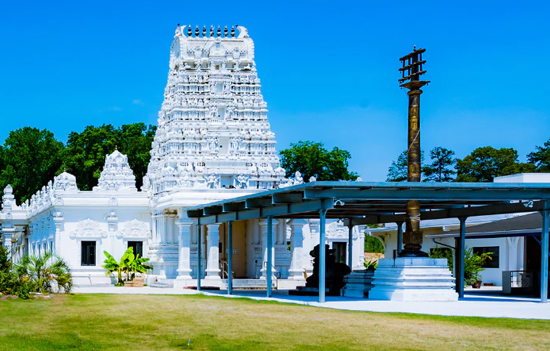 Venkateshwara temple Atlanta.
Venkateshwara temple Atlanta.
Growth of Hindu Temples in
the US
Swami Vivekananda, following his historic speech in the Parliament of World’s Religions, established Vedanta Societies in New York and San Francisco in 1890. Subsequently, centres were established in other cities but their numbers remained small.
Paramahansa Yogananda came to the US in
1920 and established several centres of the Self Realization Fellowship for
promoting yoga, popularising it through his book Autobiography of a Yogi. By the 1950s, the Self Realization Fellowship
had become the most prominent Hindu organisation in the US. During 1960s, with
the rise of counter culture, many gurus and swamis came to the US and they were
instrumental in establishing centres and ashrams; some of which are still
active.
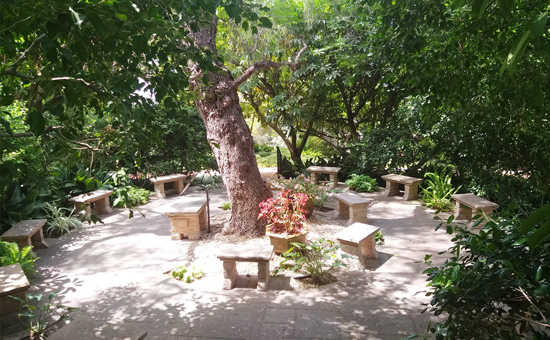 Temple of Leaves. Yogananda Ashram, Los Angeles, 2019.
Temple of Leaves. Yogananda Ashram, Los Angeles, 2019.
As more Indians adopted the US as their
second home with their families, the urge for constructing temples became more
intense, replacing sporadic attempts at constructing religious institutions.
The Hindu students and professionals who immigrated in the late 1960s and 1970s
often kept small altars and puja rooms in their homes for their religious
needs. They organised religious communities and cultural associations.
These associations rented halls, churches, and school auditoriums to celebrate Hindu festivals such as Diwali, Holi, Navratri, etc., bringing the immigrant community together. The religious groups often met in members’ homes to study the scriptures, conduct pujas, and sing bhajans. By the 1970s, the religious groups and cultural associations started creating ‘Hindu Temple Societies’ in large metropolitan areas that had substantial Hindu immigrants.
The goal of the societies was to create
permanent temples. For this purpose, existing properties such as private homes,
former churches, warehouses, and office buildings were purchased and converted
to temples. In some instances, land was purchased and new temples were built in
accordance with the Agama Shastras.
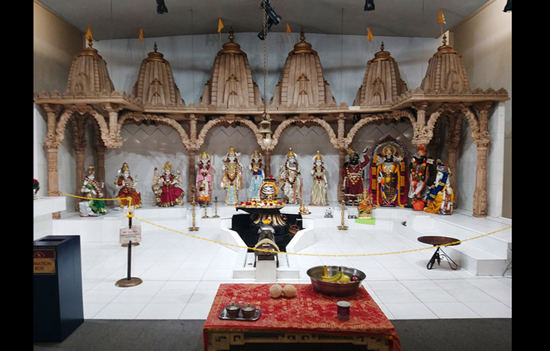 Inside Sanatan Dharam Mandir in Los Angeles. They provide free medical checkups and meets for Senior Citizens too. 2019.
Inside Sanatan Dharam Mandir in Los Angeles. They provide free medical checkups and meets for Senior Citizens too. 2019.
The Sri Venkateswara Temple in
Pittsburgh, inaugurated on June 8, 1977, and the Hindu Temple Society of North
America in New York, consecrated on July 4, 1977, were the first Hindu temples in
the US built by Indian immigrants. Spurred by the experience and the success of
these two temple constructions, many other temples of elegance were built
during the 1980s and 1990s in nearly all major metropolitan areas.
Akshardham in
Robbinsville, New Jersey, is the largest temple in the US. It
was built over a period of 12 years, on a 183-acre plot at an estimated cost of
$94 million, with contributions from 13,000 artisans hailing from different
parts of the world. It is 213 feet high and contains around 10,000 statues.
There are about 196 temples in the US and many more are under construction.
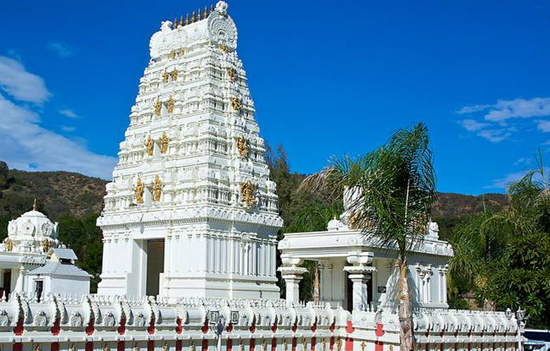 Malibu Hindu Temple in California.
Malibu Hindu Temple in California.
Temple Management
Like churches, synagogues, and mosques,
Hindu temples are eligible to be regarded as tax-exempt religious entities. A
tax-exempt entity must have an organisation and the most popular form of
organisation is that of a corporation. In general, temples, like other
religious places of worship, must be registered in the state of their location
and adhere to federal, state and local laws concerning public safety and
welfare. There is no governmental intervention in
the internal matters of temples.
As a corporate entity, a temple must
have a board of directors and its own by-laws concerning a vision statement,
eligibility criteria for membership, election/selection of office bearers, term
of office, etc. In addition to the board of directors, temples have committees
to manage different aspects of a temple such as the building, puja, finance,
cultural affairs, etc. Most of the office bearers and committee members serve
voluntarily.
Priests are selected based on their
qualifications and the requirement of the temple. They are well-respected and
are supported by the community in terms of salary, health insurance, housing,
etc.
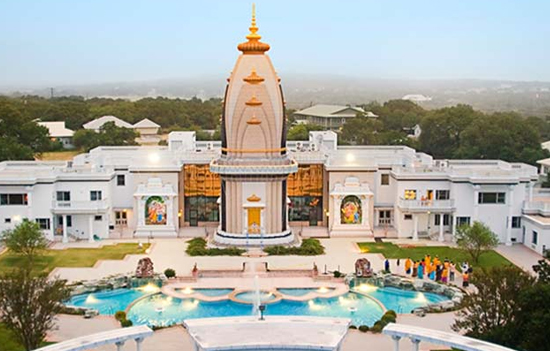 Radha Madhav Dham Texas.
Radha Madhav Dham Texas.
Not only do the temples function as
places of worship but they are also centres of
education for children and adults about the Hindu culture and religion.
At these sacred sites, Sunday schools are organised for children and
philosophical discussions are held for adults. Charitable
work is also done here by maintaining health clinics and soup kitchens
to help the poor, distressed and needy people. Through the cross-cultural
activities organised here, goodwill and understanding is fostered, promoted and
encouraged. And one of the goals of these temples is to co-ordinate and
co-operate with other similar organisations in their activities and programmes
of mutual interest.
The achievement of the immigrant Hindu
community in building and managing temples in the last few decades is quite remarkable.
It is a testimony that Hindus can manage their own temples without government
intervention and interference. Furthermore, they have demonstrated temples as
places of worship, centres of learning and focal points for social service as
temples in India used to be. This achievement of the Hindu community in a
foreign land, within a span of about 50 years, should make all Hindus proud and
this can serve as an impetus for reorganisation of management in India.
This article was first published in the Bhavan’s Journal, 1 December 2024 issue. This article is courtesy and copyright Bhavan’s Journal, Bharatiya Vidya Bhavan, Mumbai-400007. eSamskriti has obtained permission from Bhavan’s Journal to share. Do subscribe to the Bhavan’s Journal – it is very good.
Also
see albums
1. Ashrams Los
Angeles and around
2. Museum
of Fine Arts, Boston
3. Gurdwara San
Jose
4. Shanti
Ashrama, California
5. Hindu Temples in USA
6. Hindu Temples in North America